
|   |

|   |
Siddhendra Yogi Natyakalotsav 2013 - Sudha Sridhar e-mail: sudhasridhar@hotmail.com March 9, 2013 Every year during the Bhishma Ekadasi day, the heritage village of Kuchipudi springs to a life of different dimension with beehive of activity all round, and dazzling display by artistes from far and near. The unabated dissemination of knowledge from erudite scholars further lends an unparalleled atmosphere for discerning artistes to fill up the void in their dance journey. The Siddhendra Yogi Kalotsav organised by the Siddhendra Yogi Abhivrudhi Committee, Kuchipudi, started with the customary tradition – a procession, wherein the deity Siddhendra Yogi is taken around the village in a bullock cart with all gaiety along with the guests and the village elders. The four day festival schedule (Feb 21 – 24) was ideal in the sense that in the morning lec-dems / seminars were slated while the evening saw dance performances at the Kuchipudi Agraharam Heritage Village temple. This year, the festival was a tribute to Vedantam Satyanarayana Sarma. The youngsters of the traditional Kuchipudi families came together to put up a grand show under the leadership of Tadepalli Satyanarayana Sarma. Though the charismatic physical presence of Vedantam Satyanarayana Sarma was missing all through, one felt from the bottom of the heart that he has created a team of youth from the traditional Kuchipudi families with the assurance that the art form was in safe hands before his untimely departure to the brighter world. 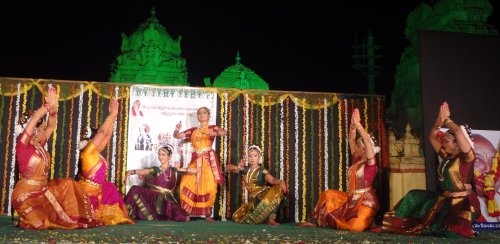 Kuchipudi by students of University of Hyderabad 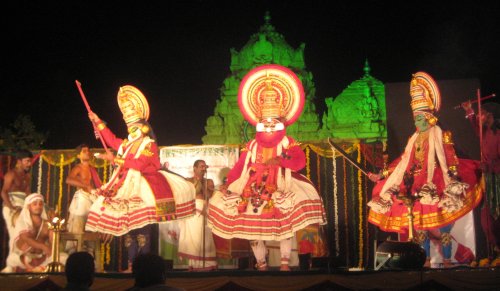 Kathakali by Krishnakumar’s group 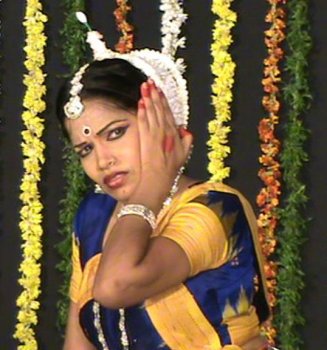 Madhulita Mahapatra 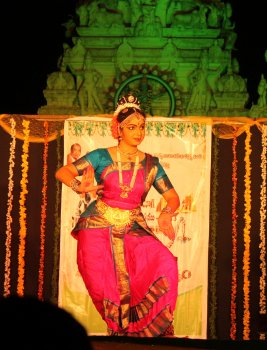 Sunanda Kolluri The festival had good participation from two generation of Kuchipudi artistes, which was also graced by the local dignitaries like the District Collector, Commissioner of Police, people representatives. This year, the festival also saw active participation from school students from in and around Kuchipudi, with the youngsters benefitting immensely from the august presence and interaction of doyens and seniors of the Kuchipudi art world. The proceedings started with 'Poorvarangam' by students of Telugu University. Pan India presence of performers (Delhi, Bangalore, Chennai, Hyderabad, Trissur, etc) in the festival along with dancers from abroad (Moscow & USA) was well appreciated and a golden opportunity for the viewers and the artistes to be part of a culturally and aesthetically rich content showcased festival. The performers included Radhika Ramanujam (Bharatanatyam), Somasekar - Sowmya (Kathak), Madhulita Mahapatra (performed Madhurashtakam and ashtapadi Yahi Madhava in Odissi), Krishnakumar’s group (performed Dakshayagnam in Kathakali) and Sandhya Tulasi from US (Kuchipudi) among others. The students of Kuchipudi guru Jayarama Rao performed a tarangam, while it was great to see Anuradha Jonnalagadda perform after a long gap, two items - an episode from Swagatham Krishna and a shloka from Soundaryalahari, her own choreography. The student group from Central University performed tarangam ‘Pashyata pashyata Bhagavantham’ and a tillana in Khamas raga during the festival. The remarkable performances enjoyed by the compact packed audience was the talk of the village next morning indicating the standard of performance and the keen interest evinced during the festival. The previous edition of the festival saw on each of the three days, staging of a Kuchipudi Yakshaganam. This year the onus of showcasing Kuchipudi Yakshaganam fell on the broad shoulders of Vedantam Venkata Rama Raghavaiah, who warmed the hearts of the purists with the performance of Bhaktha Prahalada Kuchipudi Yakshaganam. 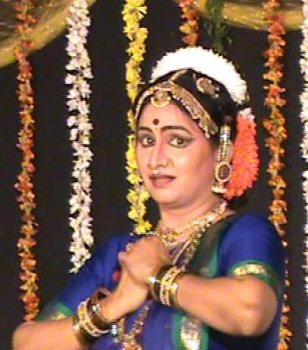 Anuradha Jonnalagadda 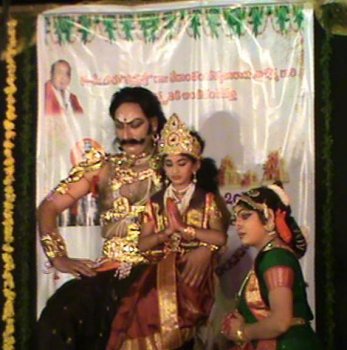 Vedantam Venkata Rama Raghavaiah as Hiranyakasipu One unique highlight of this year's festival was the performances of the distaff side from the traditional Kuchipudi families like Yeleswarupu Sarvani, Pasumarthi Sai Deepika, Pasumarthi Nagamohini and Kolluri Sunanda. The performances were watched with a happy feeling by the proud parents and grandparents from the lineage of torch bearers of the art form for centuries now. DSV Sastry, the noted Carnatic musician, composer and Kuchipudi Yakshaganam Sangeetham specialist, compiled a unique program during the course of the festival titled 'Glitters of Kuchipudi in Silver Screen' with film clippings featuring legends like Vedantam Raghavaiah, Vempati Peda Satyam, Vempati Chinna Satyam and Pasumarthi Krishnamurthy from old Telugu films bringing out the Kaisiki Vritti on movies. The beneficial influence of Kuchipudi in Telugu filmdom highlighted in the program much to the delight of the family members, was watched together by the kith and kin of the legends, with a nice feeling of happy bonding recalling the pleasant memories and contributions made by the legends of Kuchipudi. The lecture demo sessions were very informative and the wide variety of topics covered by eminent personalities of the art world was the real highlight of the festival. Dr. Uma Rao in her session brought out the positive influence of ‘Bhama Kalapam in Yakshaganam literature’ that followed like in the works of Mathru Bhoothiah and Tarikonda Vengabamba, (Vishnu Parijatham, Siva Parijatham, Parijathapaharanam) wherein the grammar, framework, repertoire, etc all followed the same lines as that of Bhama Kalapam. 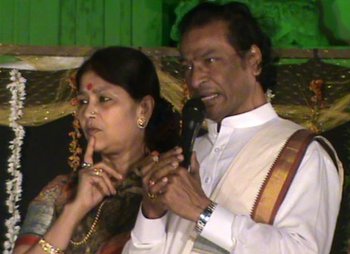 Jayarama Rao & Vanashree Guru Jayarama Rao shared his experiences of his dance journey. He clearly explained the four stages in his career akin to the split of the word Ku-chi-pu-di into four parts. He extolled the performance of Vedantam Satyanarayana Sarma in Usha Parinayam and how it influenced him to root for donning female personification roles. Jayarama Rao had thus joined the Kuchipudi Kalakshetra and was trained by Vedantam Parvatesam. Thus the four stages - his dream to succeed, extensive training at the hands of great gurus, life turning point to proceed to Delhi for greener pastures, support and help from art lovers, fellow Telugu speaking people and contributions from various quarters including coming to meet his life partner, shaped his destiny. All through the talk, he was very humble, encouraging the dance aspirants to go for their destiny in right earnest. 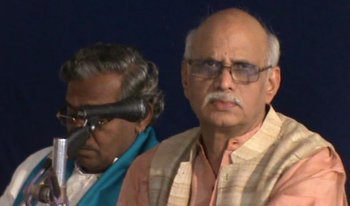 Vedantam Ramalinga Sastry & Dr. Pappu Venugopal Rao When Dr. Pappu Venugopal Rao took to stage to throw light on his topic ‘Detailed Analysis and Study of Bhama Kalpalam’ it was like the roar of a lion in the jungle claiming supremacy majestically over its territory. In his exemplary session, Dr. Rao said that a visit to Kuchipudi is also a pilgrimage on the lines of going to Kasi or Rameshwaram, because of the fact that great yogi like Siddhendra Yogi and Kshetrayya had lived in Kuchipudi. While dance traditions (nritya forms) are many there are only two classical natyams namely Kathakali and Kuchipudi. In that Kuchipudi is probably the only classical dance form that follows in totality all the elements as enumerated by Bharata muni in the Natya Sastra including grammar, structure, literature, alankara sastra. Further, he added that the origin of all types of Yakshaganam is Kuchipudi Yakshaganam and how it is Kuchipudi village’s bheeksha to our country. He emphasized on how Bhama Kalapam is very simple, comprehensible and yet so entertaining that even a commoner can understand the complicated aspect of the play. There are one lakh lakshanams like Dwipada, Daruvulu, Chandasu, Kandarthams, Pancha chamaram, Sesam, etc in Bhama Kalapam. The high point of literature and writing skills of Siddhendra Yogi could be seen yet made suitable for music without losing its sheen is a unique hallmark of the play. This actually set a trend or sort of benchmark for the authors who followed the Yogi in the discipline of literature and music in dance form. Dr. Pappu Venugopal Rao’s intense talk, scholarly and research oriented yet lucid was clearly the major highlight of the morning sessions of the festival which kept the audience spellbound throughout and guided appreciation of Bhama Kalapam for what it represents. Vedantam Ramalinga Sastry spoke about ‘Excellence of Kuchipudi dance.’ The main purport of dance to be a form of communication yet aesthetic based on strong roots, vibrant methods and easy adaptation could be seen in Kuchipudi. Demystifying of the sacred secrets and truths revealed in the Vedas and Upanishads in a simple form which anyone could easily understand, decipher and digest is Kuchipudi’s forte. Since Kuchipudi dance form puts to use all the components of dance, it was also used as a tool to increase social awareness of contemporary situations, problems or circumstances and educated all with the social themes that it portrayed. Anuradha Jonnalagadda spoke at length about ‘Kuchipudi natyam - Vempati Chinna Satyam’s choreography skills.’ For any art form to flourish, the sustained efforts over a period of time of many are acknowledged. One such colossal giant who influenced and made a remarkable impact with his stellar efforts to Kuchipudi in recent times is Guru Vempati Chinna Satyam. He has set high standards of creativity and his efforts to make the dance form suit the contemporary needs of the audience could be seen from his adaptation and extraordinary mastery of choreography skills. The secret of his success could be seen as to how even a relatively demanding dance form like Kuchipudi he made more aesthetic, indulging and compulsive for the contemporary dance enthusiast and audience and set in motion the efforts to propagate the art form worldwide. In his dance dramas, the presence of Kuchipudi Yakshaganam could be felt since he was well trained in it and his creativity in application of challenging talas like dhruva talas needs more study for appreciating his contribution. His specialty included using properties separately and also using dancers themselves as properties in a very innovative way, like for example dancers combining to depict a bullock, plough, etc. Vempati’s handling of daruvus, folklore, sensitive depiction of lullabies, bringing forth the right mood and psyche of the characters in his productions are extraordinary and takes the level of choreographies to a higher dimension altogether. His penchant for retaining the poses in Kuchipudi as shown in the various sculptures was given primary importance in his dance dramas. His precious work in standardizing steps even in kelikas (solo), handling of lokadharmi (in Srinivasa Kalyanam, Hara Vilasam, Ramayanam), working on the content of the lyric predominantly instead of matching the lyrics with each pada are all path breaking, well documented and appreciated. His efforts are lasting contributions which will be a matter of study, research and made use of for posterity. Festivals are also a great occasion to appreciate and felicitate the efforts of eminent gurus, artistes and contributors of the art form. This year, on the inaugural day of Feb 21, 2013 the Committee decided to award Vedantam Venkata Rama Raghavaiah, the prestigious ‘Sadbharatha Kalanidhi Shri Vedantam Lakshminarayana Sastry Yuva Puraskar’ award for his contribution to Kuchipudi dance. While winning the hearts of the outside world is important, when one is felicitated by the village in the presence of one’s guru in the hallowed turf of Kuchipudi, the primary seat of the art form for centuries, it is a different experience altogether. This year the festival saw felicitations of gurus who have taken the mantle of propagating the art form throughout the length and breadth of the country - Jayarama Rao and Vanashree (Delhi), Vyjayanthi Kashi (Bangalore), Lakshmi Rajamani (Bangalore), Anupama Mohan (Kochi), Rajyalakshmi Seth (Mumbai) for spreading the art form in other states. Pasumarthi Seshababu and Chinta Adinarayana from the Kuchipudi traditional family were also felicitated during the festival. Once again the festival celebrated in the heritage village has pointed out to the world that it is a revered place and primary seat of Kuchipudi art form. Though small in physical dimension, one can feel how large hearted, accommodative, vibrant the village is when it comes to art, enriched with the continued presence of the indelible dedicated work of the traditional families of Kuchipudi. |